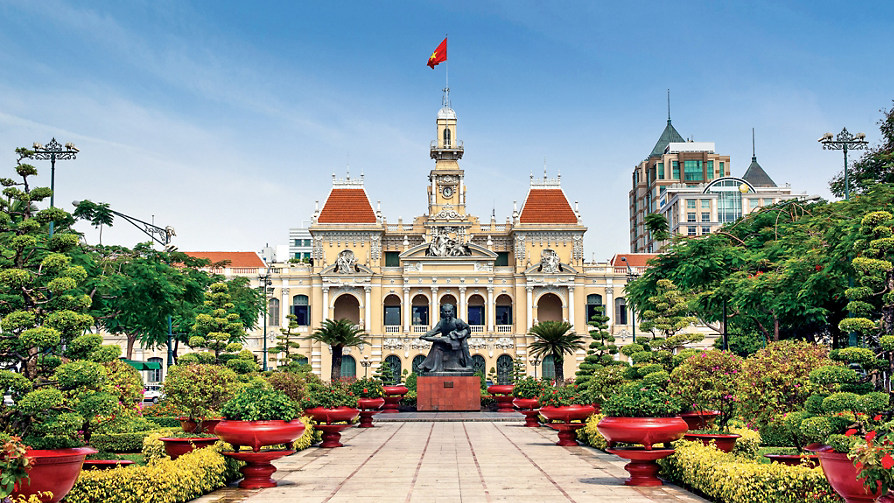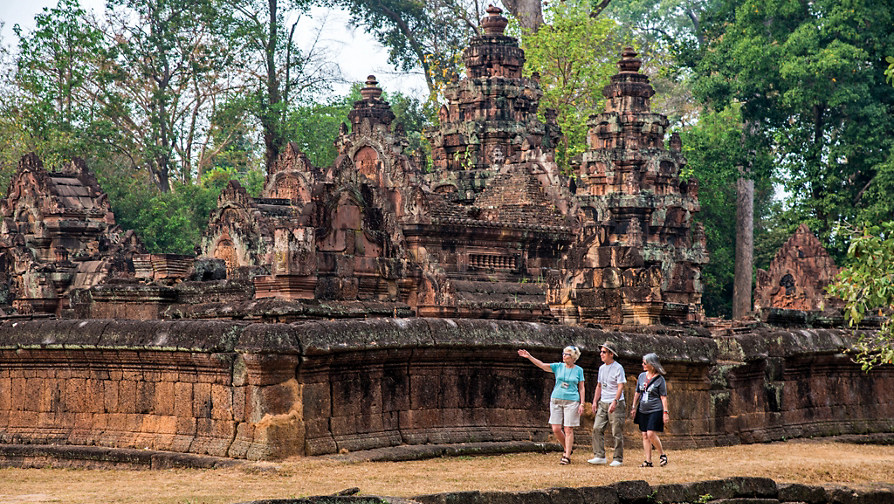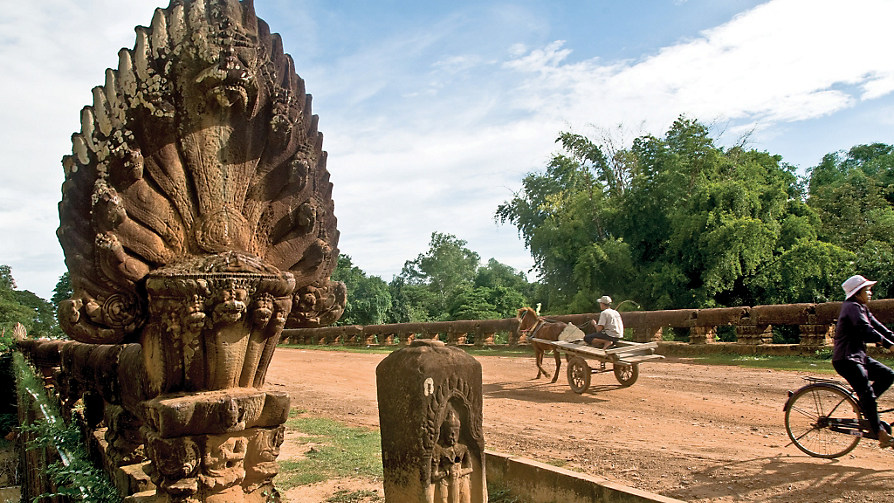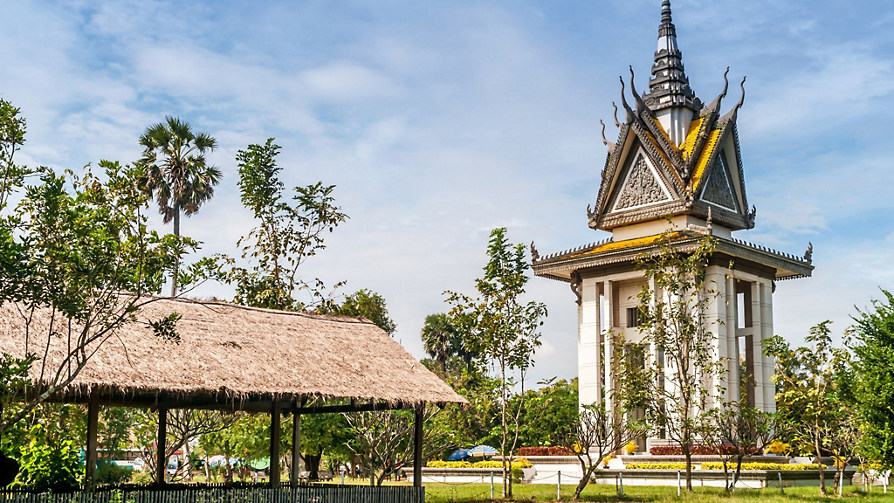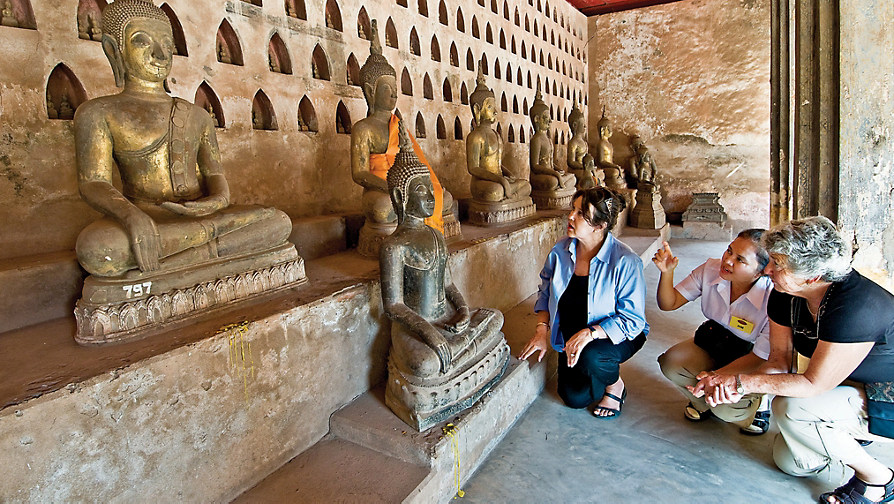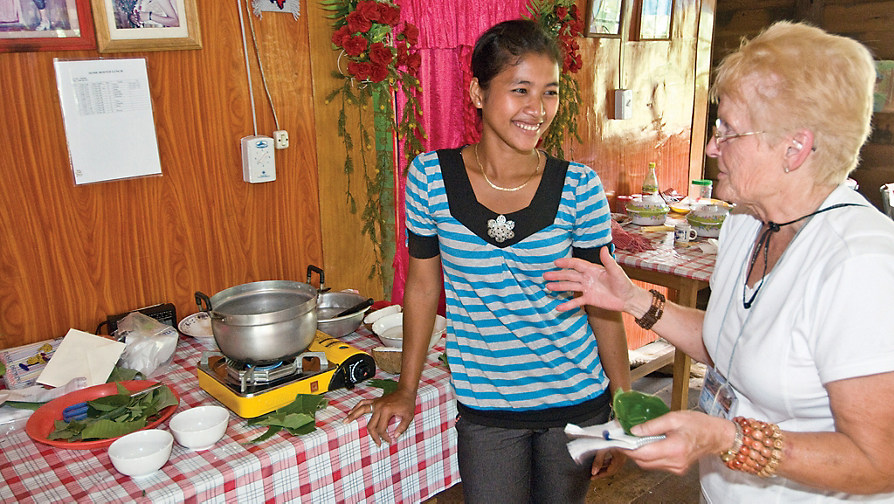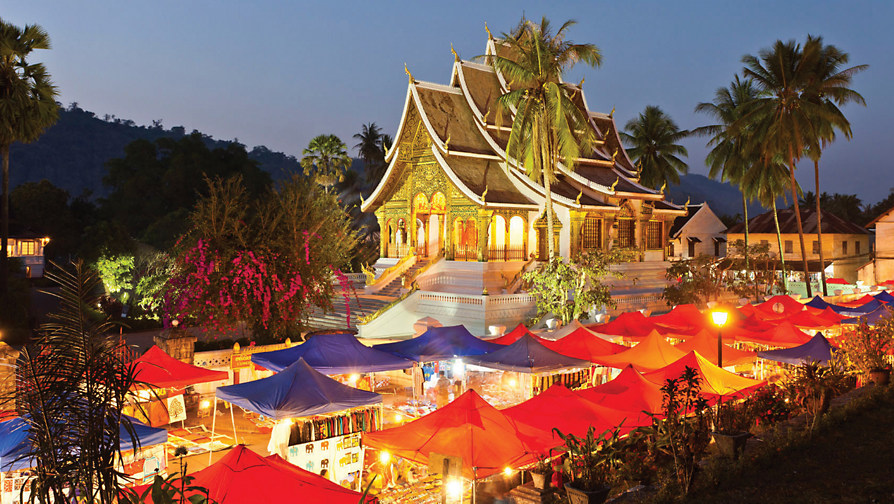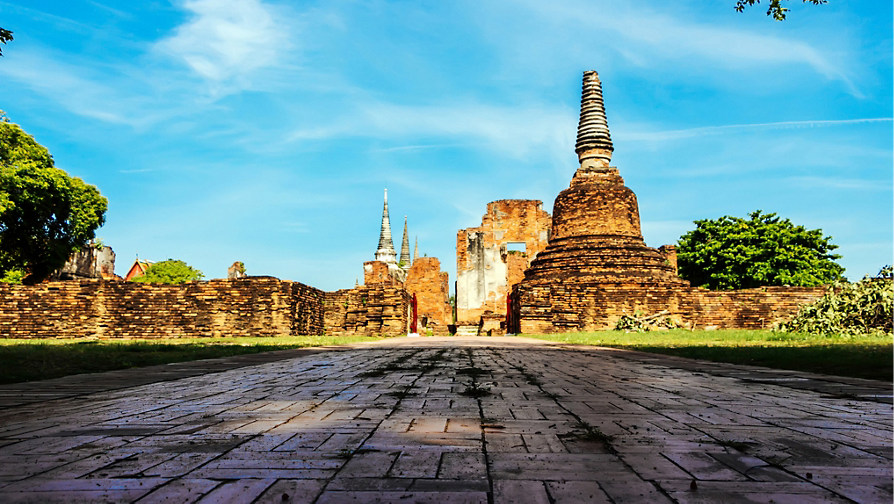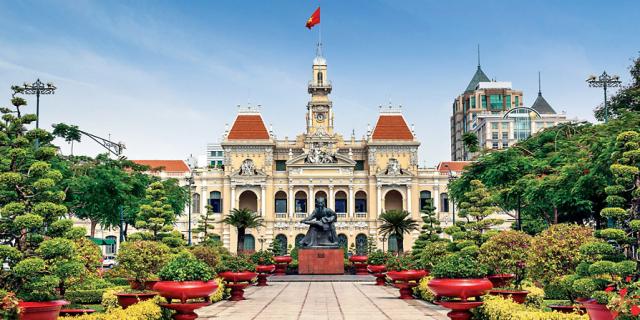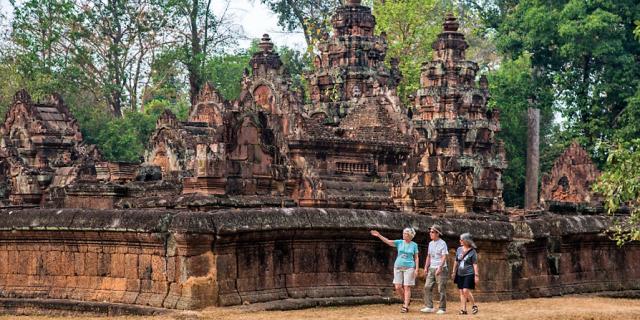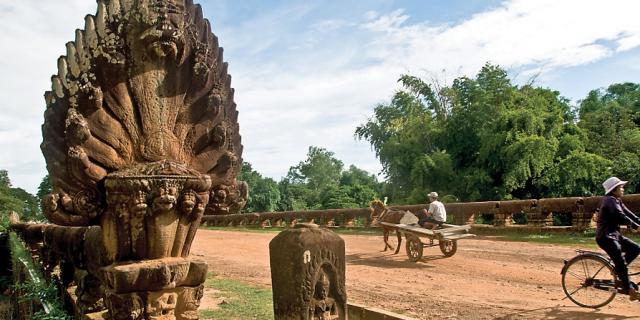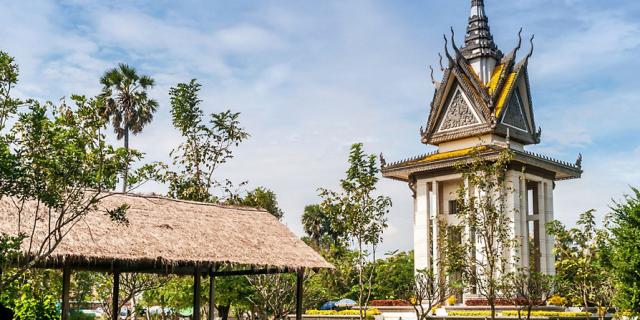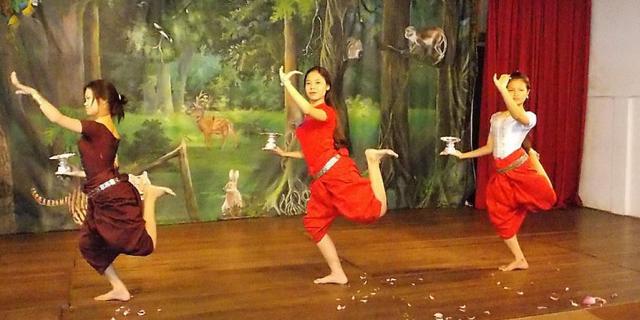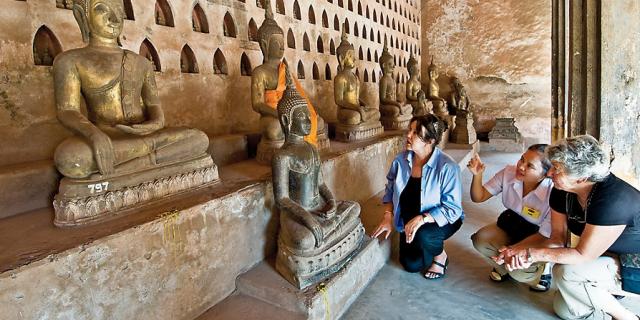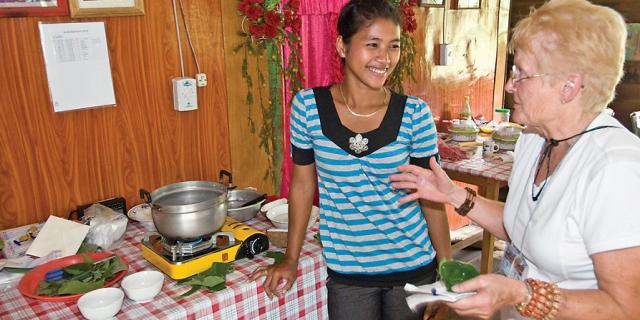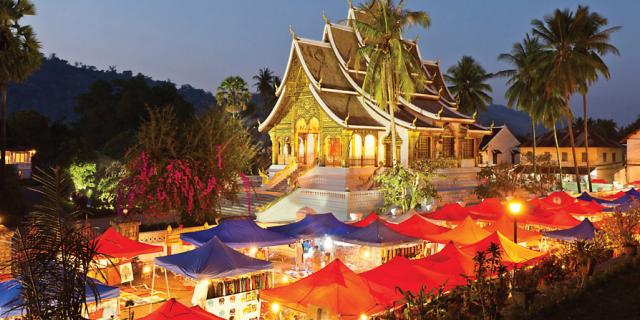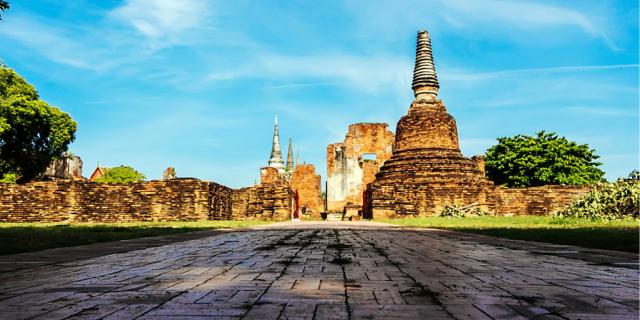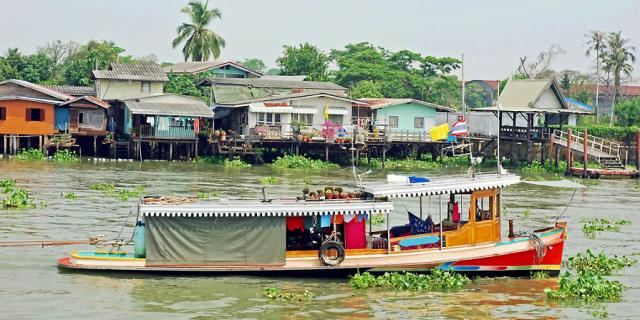- Explore in a small group of 8-16 travelers (average group size of 13)
- All land transportation and 4 internal flights
- Accommodations for 18 nights
- 40 meals—18 breakfasts, 15 lunches, and 7 dinners (including 2 Home-Hosted meals)
- 32 small group activities
- Services of a local O.A.T. Trip Experience Leader
- Gratuities for local guides, drivers, and luggage porters
- 5% Frequent Traveler Credit toward your next adventure
Please note:
Deposit requirement on land trips is $350
Past traveler savings of 5% if you traveled from 2018 onward
New travelers get $100 savings
Veer off Southeast Asia’s trodden paths to uncover the glory days of lost empires—and immerse yourself in the vibrant cultures that have emerged in their wakes. Traveling the Indochina peninsula through Thailand, Laos, Cambodia, and Vietnam, you’ll connect with locals who will share their homes, markets, and schools with you. In our small group, we'll slip into daily life in Southeast Asia for A Day in the Life of a Laotian village, where we'll meet young schoolchildren and Hmong villagers. Get a glimpse into the future of the region during a visit to a local school supported by Grand Circle Foundation; absorb the quiet tranquility of the early morning as you participate in an alms-giving ceremony with local monks; and truly get a taste of local life here when you join a Laotian family for a Home-Hosted Dinner. You'll also look beyond the iconic sites and beautiful scenery when we delve into Controversial Topics that shape life in this region, including Thailand's struggle for freedom of expression, landmines in Laos, and Viet Cong veterans' uneasy relationship with the Vietnam War legacy.
And, with a local Trip Experience Leader by your side throughout this adventure, you'll get a uniquely local perspective on Southeast Asia's history and traditions as you explore this fascinating part of the world. Behold temples and shrines devoted to Buddhist, Hindu, and animist worship; romantic remnants of French Colonial architecture; and gilded palaces that were once graced by royalty. From the grandeur of Angkor Wat’s temples to the simplicity of life along the Mekong River, it’s an Asian adventure like none other.
And whenever you’d like, you have the freedom to explore more of Southeast Asia on your own: Break off from the group for independent discoveries—like venturing to Angkor Wat in the early morning to watch the sun rise over the ancient ruins—during free time.
DAY 1
Depart U.S.
Fly overnight from the U.S. to Bangkok, Thailand, losing one day en route as you cross the International Date Line over the Pacific.
DAY 2
Arrive Bangkok, Thailand
Destination: Bangkok
Accommodations: De Prime Rangnam or similar
Evening: This evening, arrive in Bangkok where you will be met at the airport by an O.A.T. representative. You’ll take around one hour to transfer by van to our hotel, which is located in the heart of downtown Bangkok. Upon arrival, you will check in, receive your room assignments, and meet travelers who took our optional Jewels of Burma’s Irrawaddy River: Rangoon, Bagan & Mandalay or New! Sri Lanka: The Pearl of the Indian Ocean pre-trip extension. We spend four nights in Bangkok and depending on which hotel we stay at, amenities may include an award-winning Chinese restaurant, café, lobby lounge, fitness center, and outdoor swimming pool. Each of the hotel's air-conditioned rooms typically includes a safe, wireless Internet, a refrigerator, and a private bathroom. Tonight, you can rest at your hotel before exploring the city tomorrow.
DAY 3
Discover Bangkok • Local home visit • Exclusive cooking lesson & lunch
Destination: Bangkok
Meals included: B L
Accommodations: De Prime Rangnam or similar
Breakfast: Served buffet-style at the hotel starting at 6am, with Thai and American options available.
Morning: You’ll meet your small group around 11am for a Welcome Briefing at the hotel. During this briefing, we will introduce ourselves and review our itinerary in more detail (including any changes that may need to occur). Our Trip Experience Leader will also discuss logistics, safety and emergency procedures, and answer questions we may have.
Around noon, we'll board a bus and drive for about 30 minutes to the Ruan Khun Yai house, located on the banks of the Bangkok Noi Canal. Here, we’ll enjoy an O.A.T.-exclusive lesson on how to prepare traditional curry paste. During this 30-minute hands-on experience, a local woman will invite us to help her make curry.
Lunch: At the Ruan Khun Yai house around 1pm. We'll sit down to enjoy the Thai dishes that we just learned how to make.
Afternoon: Around 2pm, our hosts will lead us on a tour around their house to see what a traditional home located on the canal looks like and to share insight into their daily lives. Along the way, we'll discover a Thai spirit house, which serves as a dwelling for spirits of the dead. These spirits may be connected to the family or they may be previously connected to the home itself, but either way, the current owners of the home provide offerings to the spirits at the spirit houses. Our hosts will teach us the traditional way to pray to these spirits. Just after 2:30pm, we'll board a bus bound for our hotel, approximately 30 minutes away.
Around 3:15pm, we'll set off on an orientation walk around the vicinity of our hotel with our Trip Experience Leader. He or she will point out restaurants and sites you may want to visit during your free time here. During our walk, we'll stop to try some local street snacks and drinks. We may sample hoi tod, an egg pancake that sometimes incorporates seafood ingredients, before washing it down with roselle juice or cha Thai, an herbal drink. This is also a great opportunity to practice wai, the traditional way to greet locals by pressing your hands together and bowing. The remainder of the day is yours to do as you please. Perhaps you'll take the Skytrain, a local transit system, to the Jim Thompson House. Here, learn about the fascinating life of James Thompson—from his success as the founder of a silk-making company in Thailand to his mysterious disappearance in 1967.
Dinner: On your own. Your Trip Experience Leader can provide recommendations on the best locales for whatever your preferences are. You may seek out a restaurant that serves traditional dishes like som tum, a typical salad made with green papaya and various spices. Or, if you're worried that the spice level may be too much, perhaps you'll try a dish like tom kha kai, which is a refreshing soup that uses coconut milk to tame the kick of chilis that are also in this dish.
Evening: You are free to return to your room to rest before our explorations tomorrow, or you may venture back out to experience Bangkok’s nightlife.
DAY 4
Explore Bangkok • Visit Grand Palace • Controversial Topic: The fight for freedom of expression in Thailand with a university student • Chaopraya River dinner cruise
Destination: Bangkok
Meals included: B L D
Accommodations: De Prime Rangnam or similar
Exclusive O.A.T. Activity: Today's activities include a visit to the student union at Thammasart University, where we'll participate in a conversation about the Controversial Topic of freedom of expression in Thailand, led by a student member of a liberal, pro-free speech organization. Read below to learn more about this discussion.
Activity Note: The Grand Palace has a strict dress code. Men should wear pants, women should wear pants or long skirts that cover their knees, and both men and women should cover their shoulders. It is also recommended to wear shoes that you can easily remove as you’ll need to take your shoes off before entering the Royal Chapel. Thammasart University is closed to the public during semester examinations in May, July, and December, as well as for public holidays. If your visit falls on one of these days, you will participate in a conversation with a local activist about the struggle for freedom of expression at the hotel. We’ll also ride through the streets of Bangkok like locals when we hop aboard tuk-tuks(three-wheeled vehicles). We may drive over uneven and bumpy roads. This evening's dinner cruise is weather dependent, and water may be choppy.
Breakfast: Served buffet-style at the hotel starting at 6am, with Thai and American options available.
Morning: At approximately 8:30am, we’ll board a bus and drive for about 30 minutes from the hotel to Bangkok’s crown jewel—the Grand Palace of Thailand, a sprawling compound of ceremonial halls, gilded spires, and ornate buildings. The city's defining landmark since 1782, the palace became the centerpiece of a new Thai capital called Krung Thep (City of Angels), known outside of Thailand as Bangkok. It was King Mongkut (or Rama IV) who ruled from this palace, expanded trade with the West, and was romanticized in the musical The King and I. The focal point of the palace is the Emerald Buddha. Carved out of jade and adorned with gold, the Emerald Buddha made a dramatic appearance in 1434, when it was found hidden in a temple stupa. Since 1785, the Emerald Buddha—the most highly revered image of the Buddha—has resided in the Royal Chapel of the Grand Palace.
Around 11am, we’ll walk about 10 minutes to Thammasart University. Upon arrival, we'll meet 22-year-old Chutathip or 21-year-old Napat at the student union to participate in an hour-long conversation about the Controversial Topic of freedom of expression in Thailand. Chutathip and Napat are both students at Thammasart University and have been on the front lines of protest against Thailand's government, which they feel oppresses their freedoms. Both have faced personal and legal backlash for their progressive views. Due to the sensitive nature of this topic, we have kept their personal details to a minimum.
Over the last 15 years, freedom of expression has emerged as a politically polarizing issue in Thailand. On one side of the divide are the so-called "Yellow Shirts," a conservative, pro-monarchy, military-backed party. On the other side are the "Red Shirts," a younger-leaning, more liberal party who seek the ability to express their opinions—particularly those opinions criticizing the government and the Thai royal family—freely. In 2014, the "Red Shirt" government was overthrown as part of a military coup on the alleged basis of corruption and disrespect to the royal family. Since then, the ruling "Yellow Shirts" have gone about rewriting elements of the Thai constitution to deepen protections of the royal family, obscure public details of the military budget, and limit freedom of expression.
A 2019 election was the tipping point for many young Thais: The election was presided over by a "Yellow Shirt"-backed election commissioner, who declared the results in his party's favor. In the face of what many believe to be corrupt and anti-democratic results, students and young people across Thailand rose up to join the "Red Shirts" in protest. The Student Union of Thailand, a nation-wide university organization, joined together with Thai high schoolers to form "Free Youth," an organization devoted to advocating for freedom of expression. Since March of 2020, more than thirty student leaders of "Free Youth" have been charged by the government for violating the rules of the new constitution.
For approximately 15 minutes, Chutathip or Napat will detail their experiences in the movement and share their hopes for the future of Thailand. We'll then have about 45 minutes to ask the student our questions about this controversial issue. Keep the student's viewpoint in mind for our visit to Koh Kerd village tomorrow. It's a much more traditional community, and you may want to compare the village chief's opinion of this controversy to the one we heard from the student today.
Around 12:15pm, we'll drive about 10 minutes to our lunch spot for the day.
Lunch: At a local restaurant around 12:30pm. You’ll have a selection of dishes that you can order, including pad thai, a popular fried noodle dish that combines a variety of flavors and textures. Typically pad thai is made with beansprouts, onions, eggs, and seafood, chicken, or meat. But what gives this dish its signature flavor is the fish sauce that it is soaked in as it cooks.
Afternoon: Lunch concludes around 1:15pm, at which time you have free time to do as you please. Tuk-tuks will be available to transport us back to our hotel, about 15 minutes away. If you're interested in exploring on your own, our Trip Experience Leader would be happy to tell your tuk-tuk driver where you're headed. Perhaps you'll visit Wat Pho temple, home to the second-largest reclining Buddha statue in the world. The temple is also considered to be the birthplace of Thai massage, and you may want to indulge in one while you're there. Or simply stroll around the city to take in the exciting energy of motorcycles zipping down the streets, the fragrant smell of street food wafting from carts, and the sights of skyscrapers located next to temples and parks.
Around 5:45pm, we'll gather at our hotel and drive about 30 minutes to the pier where we’ll board a private, traditional, wooden rice barge for a cruise on the Chaophraya River.
Dinner: During our cruise around 6:15pm, we’ll enjoy a memorable Welcome Dinner—exclusive to our O.A.T. group. We'll savor traditional favorites like massaman curry, a hearty stew flavored with lemongrass, coconut milk, cardamom, and cloves. The menu will also feature khai yud sai, a Thai-style omelet stuffed with ground pork and peppers and seasoned with fish sauce, vinegar, and cilantro.
Evening: We'll cruise for about 1.5 hours, passing the Temple of the Dawn and the Grand Palace. Following the conclusion of our dinner cruise around 7:45pm, we arrive back at our hotel around 8:15pm, where you may want to retire to your room to relax.
DAY 5
Explore Ayutthaya • Koh Kerd Village visit
Destination: Ayutthaya
Meals included: B L
Accommodations: De Prime Rangnam or similar
Activity Note: Because Ayutthaya is a religious site, visitors are asked to abide by the dress code. Men should wear knee-length shorts and women should wear knee-length shorts or skirts. Today, we will drive to Ayutthaya where we’ll walk over uneven, bumpy pathways.
Breakfast: Served buffet-style at the hotel starting at 6am, with Thai and American options available.
Morning: We depart the hotel around 8:30am and we’ll drive for around 1.5 hours to the ancient city of Ayutthaya, located about 50 miles north of Bangkok. This UNESCO World Heritage Site was home to 33 kings from many different dynasties. The capital of Siam from 1353 to 1767, the city was once a place of such fabulous wealth that early travelers described its “2,000 spires clad in gold.” While here, we'll see the preserved temple ruins of Phra Sri Sanphet.
Just before 11am, we'll drive to Koh Kerd Village. Upon arrival around 11:15am, we'll travel as the locals do when we hop aboard a tram and take a ride through the valley to the village chief's home. When we arrive around 11:30am, we'll sit down with her to discuss her role as the leader of the village, as well as how she is combating the issue of children abandoning their traditions for more modern customs.
Lunch: Just after noon, we'll gather around the chief's table for a meal featuring typical Thai dishes.
Afternoon: Shortly after 1pm, we'll walk about 10 minutes to the village pier, where we'll embark the small boat that will take us back to our bus via the Chaophraya River. Our cruise concludes around 1:45pm, at which time we'll begin our return journey to the hotel, arriving around 2:45pm. The rest of the afternoon is free for you to make your own discoveries. You may want to escape the hustle and bustle of Bangkok, without actually leaving the city, by taking a stroll through the forest-like landscape of Lumpini Park.
Dinner: On your own. Perhaps you'll seek out a traditional dish like green papaya salad, a light, refreshing bite made with peanuts and dried shrimp. Or for something a little more familiar, you might try a fusion restaurant, where Thai flavors meet Western ingredients.
Evening: At leisure. If you haven't have the chance to attend a khon (masked dance) performance yet, now would be an excellent opportunity. Or return to the hotel to prepare for our transfer to Laos tomorrow.
DAY 6
Bangkok • Fly to Luang Prabang, Laos
Destinations: Luang Prabang, Laos
Meals included: B L D
Accommodations: Muangthong Hotel or similar
Activity Note: Jumbos, our main mode of transportation in Luang Prabang, can only carry five to six people at a time. Therefore, our small group will divide into even smaller groups to ride in the jumbos, and we may drive over uneven or bumpy roads.
Breakfast: Served buffet-style at the hotel starting at 6am, with Thai and American options available.
Morning: We’ll leave the hotel early—around 7:30am—for the 1-hour drive to the airport where we’ll catch a 1.5-hour flight to Luang Prabang, Laos. The ancient, royal capital of Laos is located on a peninsula between the Mekong and Khan rivers with green mountains all around. Recognized as a UNESCO World Heritage Site, this is considered one of Southeast Asia's best-preserved small towns.
Upon arrival in Luang Prabang around noon, we’ll take a bus ride to the edge of the town. Since large coaches aren't allowed in the inner city, we'll use jumbos, the local mode of transport that are similar to tuk-tuks.
Lunch: We’ll take our jumbos to a local bakery that serves typical North American dishes, arriving around 1pm. We’ll have a selection of western-style sandwiches and salads to choose from for lunch, and we’ll finish our meal off with slices of pie and cake.
Afternoon: At about 2:30pm, we'll check into our centrally-located hotel. Depending on which hotel we stay at, amenities may include a bar and restaurant. Typically, each air-conditioned rooms includes a safe, minibar, satellite TV, coffee- and tea-making facilities, and a private bathroom.
Enjoy some time to explore on your own this afternoon. Along with its scenic setting, Luang Prabang is famous for the more than 30 active temples and hundreds of architectural treasures that reside here. It will be like a journey into the distant past as we mingle with monks and local people heading to markets and going about their daily business.
Around 5pm, we'll gather and take jumbos to a nearby night market. From there, we'll enjoy an orientation walk along the Mekong River before arriving at a local ferry station just before 5:30pm. Here, we'll meet locals who will share nam paan with us, a traditional mixed fruit smoothie. A rising number of women who live in the countryside depend on transportation on the river to get into the city where they make a living by managing these snack and drink carts. We'll discuss this profession with them during our time here. While we enjoy our drinks, we'll also get a glimpse of the daily routines of locals who rely on the ferry to cross the Mekong River to get to their homes, markets, and more.
Just before 6pm, we'll walk 5 minutes to a local restaurant for dinner.
Dinner: Around 6pm at a local restaurant, featuring traditional cuisine.
Evening: Around 7pm, we'll depart for the 5-minute walk back to the hotel, where you have the option to retire to your room for the evening.
If you want to continue exploring the city this evening, you may choose to stay in the center of town where you can browse the stalls of Luang Prabang’s night market. Here, you’ll find everything from clothes and jewelry to handcrafted purses, pottery, and artwork. Jumbos typically wait along the edge of the market where you can grab one to take back to the hotel.
DAY 7
Cruise the Mekong River • Village visit • Explore Pak Ou Cave
Destination: Luang Prabang
Meals included: B L D
Activity Note: We’ll cruise for 1.5 hours in a traditional wooden boat on the Mekong River today. To access the Pak Ou Cave, you’ll need to walk up steep stairs.
Breakfast: Served buffet-style at the hotel starting at 6:30am, with Thai and American options available.
Morning: We’ll board jumbos around 9am and take a short 15-minute drive to the Royal Pier where we’ll board a traditional wooden boat. We start our day on an excursion along one of the longest rivers in the world. The Mekong River, or “mother of all rivers,” supports some 90 million people who produce rice on the surrounding 54,000 square miles of land. Also home to more species of giant fish than any other river, this majestic waterway is said to produce balls of light along its surface, which the locals attribute to the Phaya Naga, or Mekong Dragons.
We’ll cruise for around 30 minutes before stopping at Muangkham Village, an O.A.T.-exclusive experience. During our time in this small rural village located on the shores of the Mekong, we'll have the chance to interact with some of the locals, and we'll help one villager prepare a traditional snack. First, we'll watch them demonstrate how to prepare dried river weed before we have the chance to help make this tasty treat ourselves. Around 11am, we'll head back to our boat and continue on for another hour to the Pak Ou Cave. The cave, hidden in the underside of a cliff, is filled with thousands of Buddha icons. Around 1pm, we’ll return to our boat.
Lunch: Around 1pm on the boat, where we’ll savor a traditional lunch, taking in the lush scenery that passes us by as we cruise back to Luang Prabang.
Afternoon: We arrive back at the pier shortly before 2:30pm where you can take a jumbo back to the hotel. Or, you may choose to stay in town where you can walk around to admire the French architecture, pop into a bakery for an afternoon snack, or visit the Wat Xieng Thong royal temple, the city's oldest. Around 5pm, you have some time to relax, explore on your own, or you can choose to visit Big Brother Mouse, a free time activity that will be led by your Trip Experience Leader. Here, you can discover how this organization aims to make learning enjoyable for children. Shortly after arriving just after 5pm, you can join the children who will show you games, books, and more resources they use to learn. We'll conclude our discoveries here just after 6pm. Around 6:15pm, our group will gather and we'll hop aboard the local mode of transportation, jumbos, for a short ride to a nearby restaurant.
Dinner: Around 6:30pm in a local restaurant, featuring traditional cuisine.
Evening: We’ll take a jumbo back to the hotel, arriving around 7:30pm. If you choose to participate in the alms-giving ceremony early tomorrow morning, you may want to retire to your room to get some sleep, or perhaps you’ll grab a cocktail at the hotel’s bar and sit out on the patio.
DAY 8
Alms-giving ceremony • A Day in the Life of a local village • Grand Circle Foundation visit: Village school
Destination: Luang Prabang
Meals included: B L
Exclusive O.A.T. Activities: Today, we'll spend A Day in the Life of one of two neighboring Laotian villages: Tin Keo and Nonsaath. Regardless of which village you visit, you'll participate in a wealth of activities designed to help you see what life is really like in rural Laos. With the village chief as your guide, you'll meet a Hmong hill tribe shaman, visit a weaving center, and enjoy lunch at the chief's home. Our activities also include a visit to a village school sponsored by Grand Circle Foundation. Since 2012, travelers have donated more than $27,000 apiece to the two schools in these villages. Travelers who spend the day in Nonsaath village will also get to know locals at the community center. Read more about these activities below.
Activity Note: This morning, you have the option to rise very early to depart the hotel by 5:45am for the alms-giving ceremony. Then during our A Day in the Life experience today, we’ll be walking over uneven, dusty, and bumpy terrain. The local school is closed on Saturdays and Sundays.
Early Morning: You may rise very early to participate in an ancient Buddhist tradition: alms-giving to local monks. This is a quintessential part of Laotian culture and is considered to be a highlight of this adventure for many travelers. In the quiet of early morning (around 6am), we’ll take a 10-minute jumbo ride to an area where we'll wait for hundreds of monks to parade solemnly and single-file through the streets of Luang Prabang, collecting food offerings from us and the locals. Dressed in traditional Lao orange robes, the monks provide a sense of calm to the inhabitants of the city each morning.
Then around 6:30am, we'll make our way to a nearby market, where we’ll enjoy a light, local breakfast before heading into the stalls to purchase ingredients for our lunch with a village chief later today. The chief’s family will prepare several Lao specialties for us, and in return, we’ll treat our hosts to a taste of America. It’s up to your small group to decide what dish you’ll prepare.
Breakfast: After returning to our hotel around 8:15am, you’ll have approximately one hour to enjoy a cup of coffee or larger breakfast at the buffet, which features both Laotian and American options.
Morning: At about 9:15am, we’ll begin the 45-minute drive to one of two neighboring villages, where we’ll enjoy an O.A.T.-exclusive: A Day in the Life experience. The specific village you’ll visit depends on your individual departure; however, both villages are quite similar, with fewer than 500 residents apiece, representing three different ethnic groups. While nearly 80% of residents live in homes made of wood and concrete, villagers from the Hmong and Khmu tribes typically live in more modest accommodations, with bamboo walls and thatched roofs. The majority of the villagers earn their living by farming.
Upon arrival, we’ll be greeted by the village chief, an elected official who is responsible for overseeing village administration. While the chief earns a small salary in this role, he also supplements his income by working, as most of his neighbors do, on his farm or in the local general store. We'll begin getting acquainted with daily life here during a walking tour led by the chief. As we stroll, we'll meet and mingle with any residents we encounter, such as basket weavers or rice pounders.
Our walk concludes around 11am at the village school, which is supported by Grand Circle Foundation as part of the World Classroom initiative.
Since 2012, more than $27,000 has been donated to each of the village schools we visit on this adventure—thanks to our travelers’ generosity. As we’ll learn from the chief during our tour of the school, the donations have been used to install electricity, add ceiling fans, paint the interior and exterior of the building, build toilets, and add a playground and a library room.
Because these village schools are so small—with no more than 20 elementary-aged students each—one teacher is responsible for all grade levels. We’ll have the opportunity to meet the teacher this morning and engage in a 15-minute conversation about the education system in Laos. We’ll also have the chance to interact with some of the students. They speak very little English, so you may be encouraged to help them with a language lesson. You might also participate in outdoor activities or listen as the children perform a traditional song.
After our school visit concludes, we’ll make our way to a nearby community whose residents are members of the Hmong hill tribe, an indigenous people of Laos' northern highlands that make up the largest hill tribe group in Laos. Here, we’ll visit the home of a local shaman for approximately 30 minutes to learn about the local way of life—from ceremonial traditions and natural health remedies to traditional clothing, tools, and musical instruments.
Lunch: We'll make our way to the village chief’s home around 12:30pm for lunch. Using the ingredients we purchased at the local market this morning, we’ll work alongside our hosts to prepare our American contribution to the meal. At approximately 1pm, we’ll gather around the table with the chief, his wife, and several children and grandchildren to enjoy the food we’ve prepared. In addition to our own dish, we’ll enjoy the myriad flavors of Laos—fried noodles, steamed pork with herbs and sticky rice, or spinach leaf soup.
Afternoon: After bidding farewell to the chief’s family around 2pm, we'll visit the village’s weaving center, which is supported in part by Grand Circle Foundation. Here, we’ll see the local women create handcrafted textiles, and you'll have a chance to try your own hand at weaving. The traditional weaving techniques and patterns are passed down through the generations from mother to daughter. Many families even keep their own silk worms, who produce the silk that is then woven into complex patterns.
Our A Day in the Life experience ends around 2:45pm, when we’ll leave the village for the hotel. Back in Luang Prabang shortly before 3:30pm, the rest of the day is free for you to make your own discoveries.
Dinner: On your own. You may ask your Trip Experience Leader where you can find a restaurant that serves traditional dishes, like one made with black sticky rice. Similar to the white rice that we're accustomed to, black rice has a hint of natural sweetness to it so it is sometimes incorporated into desserts.
Evening: On your own—you may retire to your room to rest before tomorrow’s explorations. Or, you may take a jumbo to the night market to grab any last-minute souvenirs.
DAY 9
Fly to Vientiane • Home-Hosted Dinner
Destination: Vientiane
Meals included: B D
Accommodations: Sabaidee @ Lao Hotel or similar
Exclusive O.A.T. Activity: Today you'll savor an authentic slice of life in Laos during a Home-Hosted Dinner with a family in Vientiane. In smaller groups of no more than 5, you'll dine on traditional, homemade cuisine and enjoy spirited conversation about local customs and lifestyles. Read more about this activity below.
Breakfast: Served buffet-style at the hotel starting at 6:30am, with Laotian and American options available.
Morning: You have the morning to relax before we leave the hotel around 10:30am for the airport. We’ll stop along the way at a local bakery where you can purchase a sandwich or salad to enjoy for lunch later today. We continue to the airport, arriving around 12:15pm.
Lunch: After checking in for our flight to Vientiane and going through security, you’ll have time to enjoy the meal you purchased at the bakery earlier this morning before our flight.
Afternoon: Around 1:30pm, we’ll take a 45-minute flight to Laos’ easy-going capital. Home to nearly one million residents, Vientiane is Laos' economic engine. While commercial trading and tourism have long been the city's economic backbone, Vientiane has experienced a boom in recent years as a result of foreign investment. Despite its growing influence and population, the city still retains a small-town feel: Laundry dries in the sun on French-style balconies, and street vendors spread out their wares on blankets and banana leaves.
We arrive around 2:15pm and take a short drive to the hotel where we’ll check in. Depending on where we stay, our centrally-located hotel should feature amenities like a restaurant and outdoor bar. Each air-conditioned room should include a satellite TV, complimentary Internet access, and a private bathroom. The remainder of the afternoon is yours to settle in or explore independently.
Dinner: At approximately 6pm, we'll re-convene in the hotel lobby, where we'll meet members of the families we'll be joining for our Home-Hosted Dinner this evening. To ensure an intimate experience, we'll break into even smaller groups for no more than 5 travelers for this special meal.
All of our host families live in either the Saysetha district or the Sikhottabong district, two middle-class neighborhoods located approximately 30 to 45 minutes from our hotel. Upon arrival, we'll meet the rest of the family, enjoy a tour of the home, and begin our cultural conversations. Because we'll be joined by several generations, our discussions will likely cover a range of topics—from the primary, secondary, and collegiate education systems in Laos; to local wedding traditions; and employment opportunities in Vientiane. We may even find some commonalities between our two cultures.
Our hosts will also invite us to help them prepare dishes for dinner, which may include tam mark houng, a traditional green papaya salad made with lime and garlic, and laab, a spicy minced pork salad with mint.
Evening: We’ll return to the hotel around 8:30pm where you may retire to your room to rest before tomorrow’s explorations, or you may take advantage of the hotel’s outdoor bar and lounge area.
DAY 10
Vientiane • Controversial Topic: The ongoing threat of unexploded bombs in Laos with victim Phouma or Tim Keokhiew & advocate Phawadee Keomouansaen • Meet a Buddhist monk • C.O.P.E. Center tour
Destination: Vientiane
Meals included: B L
Accommodations: Sabaidee @ Lao Hotel or similar
Exclusive O.A.T. Activity: Today’s discoveries feature the Controversial Topic of the ongoing threat of unexploded bombs in Laos, which have killed or injured more than 20,000 civilians since the end of the Vietnam War. During our visit to the C.O.P.E. Center, which provides prostheses and rehabilitation services to survivors, we’ll meet with a victim and a C.O.P.E. representative to learn about the devastating impacts of this countrywide crisis. Read more about this experience below.
Activity Note: Men should wear knee-length shorts and women should wear knee-length shorts or skirts for the Wat Sisaket visit.
Breakfast: Served buffet-style at the hotel starting at 6:30am, with Laotian and American options available.
Morning: We’ll set out at by bus around 8:30am to explore some of the famous city landmarks of Vientiane. Pronounced “Vieng Chan,” the capital of Laos is a slow-paced, friendly city of some 600,000 people. First, we'll visit Wat Sisaket, the oldest Buddhist monastery in Laos featuring more than 6,800 images of the seated Buddha in wood, stone, and bronze. We’ll have the special opportunity to sit down with a Buddhist monk to learn about why men in Southeast Asia become monks and what their daily routines are like—an O.A.T.-exclusive activity.
Then around 10:15am, we'll arrive at our next destination: the C.O.P.E. Center (Cooperative Orthotic and Prosthetic Enterprise), a non-government organization (NGO) that supports victims of bombs that were dropped over Laos during the Vietnam War, but failed to detonate on impact. Since 1973, more than 20,000 civilians have been injured or killed by these unexploded bombs. As we’ll learn from the staff members who greet us this morning, C.O.P.E.’s mission is to provide prostheses and physical rehabilitation to survivors and to educate visitors about this crisis.
Our own education begins around 10:45am, with a 45-minute visit to the C.O.P.E. Center Museum. Then, around 11:30am, we’ll gather in a private room to discuss this Controversial Topic with one of the victims—either Phouma Keokhiew or his wife, Tim, both of whom were permanently disfigured by unexploded bombs in the 1970s. 69-year-old Phouma lost both of his legs while serving in the Royal Lao Army. Tim, now 48, lost a leg and an eye when she stepped on a bomb in her parents’ backyard when she was just 5 years old. We’ll also be joined by Phawadee Keomouansaen, a representative from the C.O.P.E. Center who works with bomb victims and oversees the distribution of foreign funds. Together, our speakers will put a human face on this interminable tragedy.
Between 1964 and 1973, the United States Army scattered more than 2 million tons of explosives along the Ho Chi Minh Trail, which Communist forces used to transport troops and supplies between Vietnam and Laos. When this so-called “Secret War” ended, approximately 78 million live bombs were left behind.
Today, the majority of these munitions are buried under peoples’ homes or in farmlands. Because the economy of Laos is largely agrarian, tens of thousands of Laotians face considerable risk whenever they work the fields, and farmers who are wounded by bombs often lose their livelihoods.
The most common type of explosive hidden in Laos is the small, ball-shaped cluster bomb. To unwitting children, especially in impoverished communities where toys are hard to come by, these bombs peek out of the ground like irresistible playthings. Unsurprisingly, 40% of victims within the last decade have been children.
Of the 20,000 civilians that have encountered one of these explosives since the end of the war, 5,000 have lost their lives. Approximately 13,500 of the survivors are living with permanent deformities and require ongoing medical support, long-term care, and financial assistance.
Since the early 1990s, foreign governments have poured millions of dollars into Laos to provide aid to victims and to facilitate the removal of the unexploded bombs. In 2016, President Obama committed an additional $90 million in aid to Laos, on top of the $15 million that the U.S. was already providing annually. Unfortunately, bomb disposal and victim support are expensive undertakings; the Lao National Unexploded Bomb Clearance Agency is suffering from a budget shortfall of $4.5 million. And because the process for removing the explosives is so slow and methodical, experts estimate that it could take up to 200 years to clear all the live munitions.
During our hour-long conversation, Phouma or Tim will detail their own encounters with unexploded bombs and explain how the trauma has impacted their lives—from obtaining prostheses, to finding jobs, and integrating into society. Phawadee, the C.O.P.E. representative, will share her experiences working with victims and provide more information about how foreign funds are used. After listening to our speakers for approximately 20 minutes, we’ll have 40 minutes to ask the questions we’re sure to have.
Lunch: Around noon, we'll head to a local restaurant for a traditional lunch.
Afternoon: We'll take a short walk back to our hotel, arriving around 1:15pm. You’ll have free time to make your own discoveries.
Dinner: On your own. You may seek out a restaurant that serves Laos' national dish, laap. This popular, and simple, meal is made of minced meat, garlic, onion, and fish sauce.
Evening: On your own—you are free to return to your room to rest before your explorations tomorrow, or you may venture out to experience Vientiane’s nightlife.
DAY 11
Vientiane • Fly to Phnom Penh, Cambodia • Visit the Champey Academy of Arts
Destinations: Phnom Penh, Cambodia
Meals included: B D
Accommodations: Phnom Penh Katari Hotel or similar
Activity Note: The Champey Academy of Arts is closed Sundays and public holidays. If your visit falls on one of these days, you may visit the academy on Day 12. Also, we’ll use remorks, a popular mode of transport, throughout our time in Cambodia. Similar to the jumbos in Laos, we’ll divide into smaller groups to ride in the remorks.
Breakfast: Served buffet-style at the hotel starting at 6:30am, with Laotian and American options available.
Morning: We depart the hotel around 9:30am for the airport where we’ll catch a flight to Phnom Penh, Cambodia around 11:30am.
Lunch: A light lunch will be served during our flight today. You may want to purchase a snack at the airport.
Afternoon: We’ll fly for 1.5 hours before landing in Phnom Penh around 1pm. Upon arrival we’ll transfer to our hotel, stopping along the way at the Champey Academy of Arts, an opportunity exclusive to O.A.T. travelers, as few American tour companies go here.
The Champey Academy strives to preserve Khmer culture, and while here, a group of students will show us some traditional dances that showcase the history of their country. Then, it’ll be our turn to try out some moves as the children teach us a traditional dance. We’ll also view some of the handcrafted goods and artwork that the students produce here.
We arrive at our hotel around 4pm and you’ll have some free time. Depending on which hotel we stay at, amenities may include two restaurants and a bar. Each air-conditioned room typically includes a TV, Internet access, and coffee- and tea-making facilities.
Dinner: Around 6pm, we'll depart the hotel and ride for around 20 minutes in remorks to a local restaurant where we'll have a traditional dinner.
Evening: We return to the hotel around 7:30pm. You have the freedom to spend the rest of your evening as you wish, whether you want to retire to your room to rest before tomorrow’s discoveries or join your fellow travelers for a nightcap in the hotel bar.
DAY 12
Phnom Penh • Controversial Topic: The quest for justice at the Khmer Rouge Tribunal with a genocide survivor • Visit Killing Fields of Choeung Ek & Tuol Sleng Prison Museum
Destination: Phnom Penh
Meals included: B L
Accommodations: Phnom Penh Katari Hotel or similar
Exclusive O.A.T. Activity: During our time at the Tuol Sleng Prison Museum we will also meet with a survivor of the prison to learn about the Controversial Topic of the Khmer Rouge tribunal. Despite U.N. support and funding, the tribunal has failed to achieve justice for the genocide survivors in any meaningful way. Read more about this experience below.
Activity Note: Today’s visits to the Killing Fields and Tuol Sleng Prison Museum cover particularly difficult subject matter. While it may be hard to hear the specifics of this point in Cambodia’s history, it is important to learn about to better understand the country’s current political landscape. You’ll also walk around for approximately one hour on some unpaved pathways. The Daughters of Cambodia organization, which is an elective activity, is closed on Sundays.
Breakfast: Served buffet-style at the hotel starting at 6:30am, with Cambodian and American options available.
Morning: We leave the hotel around 8am and drive for 30 minutes to the Killing Fields of Choeung Ek—a grim reminder of Cambodia's bloody past under Pol Pot and the Khmer Rouge. It is almost inconceivable to confront the nature of true evil here in this gentle land, but the Buddhist memorial at Choeung Ek commemorates the 1.7 million victims (about 25% of Cambodia's population at the time) of the 1975-79 genocide. This execution site is one of many throughout Cambodia.
The Khmer Rouge came to power under the Marxist leader Pol Pot, who sought to turn Cambodia into a socialist, agrarian republic. Anyone who opposed those aims—and in particular, Cambodian intellectuals—were rounded up, imprisoned, and murdered.
We’ll spend around an hour walking through the Killing Fields before we head to the Tuol Sleng Prison Museum, arriving around 10:30am. We’ll learn about the atrocities committed here, where more than 10,000 prisoners were held before they were led to the Killing Fields. Out of the thousands of victims that were imprisoned in Tuol Sleng, there were only seven survivors. We have the special privilege to meet with one of them today to hear their deeply moving story as we discuss the Controversial Topic of the Khmer Rouge tribunal.
In 2006, the Khmer Rouge tribunal was set up to seek justice for the victims and survivors of Pol Pot's genocide by trying the leaders "most responsible" for these crimes. The tribunal is a hybrid court, established jointly by the United Nations and by the Cambodian government, and features both local and international judges. But disappointingly, after more than 10 years and $300 million, the court has convicted only three high-ranking Khmer Rouge officials—a blow to the remaining survivors. Instead, many of the genocide's perpetrators have managed to escape trial altogether as a result of their positions in the current Cambodian government.
While millions of Cambodians have followed along with the tribunal, either by attending trials in person or by watching on television or online, many feel there is nothing to be done to get justice for the victims, and they would rather not re-live the war. As we'll learn, this puts survivors with a vested interest in the tribunal outcomes in a tricky position. To learn more about this, we'll hear from one of the remaining survivors of the Tuol Sleng prison. While the survivor we speak with will depend on the day of your visit, all of the survivors experienced unimaginable horrors, including the death of their family members. As such, we will want to approach this conversation with sensitivity and care. You'll have time to ask questions about their experiences, and about what they hope for the future of both the tribunal and their government, during the hour or so we spend with them.
We then board our bus and depart for a local restaurant just after 12:30pm.
Lunch: Around 12:45pm at a local restaurant. We’ll have a family-style meal that allows us to sample several different traditional dishes.
Afternoon: Arrive back at the hotel around 2pm where you have the rest of the day to make your own discoveries. You may take a remork to Phnom Penh’s riverfront park to take in the sights and sounds of the city. Locals regularly have aerobic dance classes at the park, which you can join, or you can take a relaxing stroll along the edge of the water. You may also choose to visit the Daughters of Cambodia organization around 3pm. You'll spend about an hour with some of the organization's employees to learn how they help free women from the sex industry and how they help them build lives for themselves. The on-site spa is staffed by a few of these women; if you would like to support the organization, you may want to indulge in a massage or nail treatment before returning to the hotel.
Dinner: On your own. Your Trip Experience Leader can provide recommendations if you’d like to venture out for Cambodian favorites like amok, a thick and flavorful curry typically made with fish, garlic, coconut milk, and more.
Evening: On your own—you may want to retire to your room to get some sleep before our early start tomorrow morning, or perhaps you’ll visit the Elephant Bar at Raffles Hotel Le Royal where you can grab a drink and explore this fascinating hotel. Built in the late 1920s, the hotel was frequented by journalists and foreign diplomats—Jacqueline Kennedy even stayed here.
DAY 13
Phnom Penh • Overland to Siem Reap • Local interaction
Destination: Siem Reap
Meals included: B L D
Accommodations: Regency Angkor Hotel or similar
Activity Note: Our overland transfer to Siem Reap will take approximately eight hours in an air-conditioned bus, with included stops for lunch and activities en route.
Breakfast: Served buffet-style at the hotel starting at 6:30am, with Cambodian and American options available.
Morning: We board our bus around 7:45am and begin our 8-hour overland drive to Siem Reap. During our journey, we’ll pass through the Kampong Cham and Kampong Thom provinces where we’ll pass scenes of everyday life. We’ll see expansive landscapes of rice fields and towering palm trees where farmers tend to their crops and Brahman cows and water buffalo graze.
Depending on availability, we may stop at around 9:15am at the home of a local woman who hunts for tarantulas, cooks them, and sells them at her village’s market. We’ll have the opportunity to learn about her unique profession before we trek into the forest surrounding her home to hunt for tarantulas with her. Then, she’ll show us how she prepares these arachnids—and we may have the chance to sample the fried spiders. We’ll leave her home around 9:45am and continue our journey.
Lunch: Around noon, we’ll stop at a local restaurant for lunch, featuring family-style regional cuisine.
Afternoon: We leave the restaurant around 1pm and continue driving to our next stop: Kampong Kdei Bridge. Built around 1,000 years ago, the structure holds its title as the world's longest corbelled arch bridge.
We arrive in Siem Reap around 2:45pm and head to the hotel to drop our bags off. Just before 4pm, we'll set off on a 30-minute orientation walk to acquaint ourselves with the area before we return to our hotel where we’ll check in. Depending on where we stay, our hotel may include two dining rooms, an outdoor pool, an outdoor bar, and a spa. Each air-conditioned room typically includes a TV, Internet access, minibar, safe, coffee- and tea-making facilities, and a private bathroom.
You have some free time this afternoon to get settled in at the hotel, or you may take a remork to a local market in search of souvenirs—don’t forget to haggle.
Dinner: We’ll gather at the hotel’s restaurant at about 6:30pm for dinner. We’ll enjoy Western-style cuisine for our meal this evening.
Evening: On your own—you may retire to your room to get some sleep before our early start tomorrow. Or, perhaps you and your fellow travelers will head to the hotel’s outdoor bar for a nightcap to discuss your discoveries thus far.
DAY 14
Siem Reap • Visit a floating village • Controversial Topic: Cambodian healthcare inequality with Chea, the village midwife • Explore Angkor
Destination: Siem Reap
Meals included: B L
Accommodations: Regency Angkor Hotel or similar
Exclusive O.A.T. Activity: During our visit to the floating village this morning, we'll learn about the Controversial Topic of Cambodia's corrupt healthcare system during a discussion with the village midwife. If the midwife is not available, we will meet with the village chief, who works with several non-governmental organizations (NGOs) to improve local healthcare access. Read more about this conversation below.
Activity Note: Depending on the season, our drive to the local village and the boat pier may be particularly bumpy as we’ll pass over dirt roads that have been eroded by rain. Once we reach the village, we’ll get a glimpse into Cambodia’s past as we ride on traditional buffalo-drawn carts, passing over uneven, dusty, and bumpy roads. We’ll also ride in a wooden boat for around one hour later this morning.
Breakfast: Served buffet-style at the hotel starting at 6:30am, with Cambodian and American options available.
Morning: At approximately 8am, we’ll drive for about an hour out to a local village where we’ll ride in traditional buffalo-drawn carts in pairs. We’ll take in scenes of daily life as we ride through the village for about 30 minutes before we meet up with our bus. We’ll transfer to the pier, arriving around 10am (or longer, depending on the season), where we’ll take an exclusive, private boat to visit the nearby floating village, which is home to approximately 300 people.
We’ll spend 1.5 hours discovering how this isolated community has built homes, gardens, and schools on the water before we stop at one of the homes to get a closer look. The homeowners, Chea Ny and Yory Boun, will sit down with our group to discuss life in the village and how it is impacted by a Controversial Topic: inequality and corruption in the Cambodian healthcare system. The matriarch of the family, Chea, has a particularly special role in the community: She's been the go-to midwife for 40 years. Known throughout the village as "Big Mom" and "Hero Lady," Chea is available to help deliver babies at any time of day and never accepts compensation. But her selfless work was borne out of necessity, as the local healthcare system provides few other options to expectant mothers.
While Cambodia offers state-run healthcare with public hospitals, many Cambodians are either unable to access adequate care, or the care they receive is poor. From the floating village, for example, it takes a 1-hour boat ride followed by a 1-hour drive to reach the nearest medical facility. Because of their geographical isolation, many villagers choose to forego routine medical care, resulting in malnutrition, illness, and high rates of infant mortality.
At the same time, corruption is rampant among the country's high-ranking medical official and healthcare providers. It's common for public officials to pay money in exchange for government or hospital positions, and it's believed that 5-10% of the public healthcare budget goes "missing" every year. The issue is compounded by stark levels of socioeconomic inequality in the country: upper-class Cambodians are able to afford private hospitals, and some government officials have even been known to fly to Singapore or Thailand for medical treatment. Meanwhile, Cambodia's poor must make do with the inadequate public hospitals.
Chea, who has 10 children and 23 grandchildren of her own, will share a unique perspective on the country's healthcare woes. During our hour-long conversation, we'll hear about the health difficulties members of the village face and about what's being done to improve the situation. For example, the current government recently established an anti-corruption unit to crack down on unscrupulous state officials in the healthcare sector and beyond, resulting in hundreds of arrests. We'll also have time to ask our questions about life in the floating village before we board our boat and make our way back to dry land.
Lunch: Around 11:30am, we’ll take a 30-minute bus ride from the pier to a local restaurant. Enjoy typical Cambodian cuisine for lunch today before a 5-minute ride back to the hotel, arriving around 1:30pm.
Afternoon: Take a couple of hours to rest back at the hotel or explore Siem Reap on your own before our group gathers at 3:30pm to board a small bus and head to Angkor.
We’ll get our first glimpse of Angkor today, a holy city that took centuries to build and whose scale is still breathtaking today—it sprawls across an area of roughly 96 square miles. The Khmer Empire aristocrats who built the temples and monuments here between AD 800-1200 were motivated by their Hindu and Buddhist beliefs.
We arrive in Angkor around 4pm and we’ll have about an hour to explore Angkor Thom. We'll visit the 12th-century Bayon temple where we'll be greeted by over 200 smiling faces. Hidden in plain sight of the structure's 54 stone towers are massive grinning heads that symbolize the spirit of one of Cambodia's most beloved kings, Jayavarman VII. We'll also make a brief stop at the Terrace of the Elephants, where a series of almost life-sized bas-reliefs depict the huge beasts, before returning to the hotel by about 5:30pm.
Dinner: On your own. Your Trip Experience Leader will be ready with recommendations for you, should you like to venture out to a local restaurant. You may choose to seek out a traditional dish like Khmer red curry, a classic curry made with coconut milk.
Evening: Enjoy free time this evening. You can retire to your room to get some sleep before our full day of exploring Angkor tomorrow, or you may take a remork to explore the charming shops and cafés of Siem Reap.
DAY 15
Siem Reap • Explore Angkor Wat temples
Destination: Siem Reap
Meals included: B L
Accommodations: Regency Angkor Hotel or similar
Activity Note: Today’s activities include about three hours of walking through three miles of Angkor Wat on uneven surfaces and up steep stairs. Angkor Wat has a strict dress code. Men and women should wear pants or knee-length shorts, and cover their shoulders.
Breakfast: Served buffet-style at the hotel starting at 6:30am, with Cambodian and American options available.
Morning: We leave the hotel around 8:30am this morning and drive approximately 30 minutes to Angkor Wat, a masterpiece of Khmer architecture. Angkor Wat is a large pyramid temple, built between 1113 and 1150, surrounded by a great moat 570 feet wide. Note the bas-relief carvings throughout the temple, and take a moment to stand in the courtyard of this temple whose towers represent Mount Meru, the center of all physical and spiritual universes and the home to many gods in Hindu and Buddhist mythologies. Around 11:15am, we'll depart Angkor for a 30-minute drive to a local restaurant.
Lunch: At a local restaurant just before noon, featuring the traditional Cambodian dishes we have come to know.
Afternoon: Around 1pm, we’ll arrive back at the hotel where you’ll have a couple of hours to yourself before we set off to explore Ta Prohm. Unlike Angkor Wat, Ta Prohm has been left the way it was found, covered by a dense jungle of trees and roots, allowing you to discover this archaeological treasure just as it was found by the French in the mid-1800s. The site is most famous for its strangler fig trees whose roots seemingly drip down over Ta Prohm’s temple and its appearance in the Lara Croft: Tomb Raider movie.
After exploring Ta Prohm for an hour, we return to Angkor Wat, around 5:15pm, where we'll toast to our discoveries as we watch the sun set.
Dinner: We will arrive back at the hotel around 6:30pm, where you can enjoy dinner on your own, either at the hotel or at a local restaurant.
Evening: Your evening is on your own—you are free to rest in your room to prepare for tomorrow’s discoveries, or reach out to your Trip Experience Leader for recommendations on things to do in the area.
DAY 16
Siem Reap • Optional Banteay Srei tour • Fly to Ho Chi Minh City (Saigon), Vietnam
Destinations: Ho Chi Minh City (Saigon), Vietnam
Meals included: B L
Accommodations: Huong Sen Hotel Saigon or similar
Breakfast: Served buffet-style at the hotel starting at 6:30am, with Cambodian and American options available.
Morning: Enjoy free time to make your own discoveries. Or you may choose to join our Optional Tour this morning to visit Banteay Srei, one of the oldest and best-preserved temple sites in Cambodia. Built in AD 967, Banteay Srei means “Citadel of Women,” and is recognized as a tribute to female beauty. Leave the hotel by bus at 8am for the temple, followed by a 15-minute drive out to a local village, where we'll visit with a Khmer noodle maker and learn the secrets of making the dish that is closest to the hearts of Cambodians. You’ll return to the hotel around 11:45am and rejoin our group. At around 12:45pm, we'll all take a 10-minute bus ride to a local restaurant.
Lunch: At a local restaurant just after 1pm, featuring traditional Cambodian dishes.
Afternoon: We’ll spend our last couple of hours in Siem Reap at the Angkor National Museum where we’ll trace the history of the Khmer empire through its comprehensive collection of relics that span from the pre-Angkor Period to the great Khmer kings, and more. At about 4:30pm, we’ll take a short drive to the airport where we'll check in for our flight.
Dinner: On your own around 5:15pm at the airport. The airport offers a mix of western and traditional options.
Evening: Just before 6:30pm, we’ll catch a 1-hour flight to Ho Chi Minh City. After a half-hour drive from the airport, we'll arrive at our hotel around 8:30pm and check in. Depending on which hotel we stay at, amenities may include a pool, restaurant and bar, and a fitness center. Typically, each of the air-conditioned rooms have wireless internet access, a TV, minibar, and a private bathroom.
DAY 17
Ho Chi Minh City • Mekong Delta discovery
Destination: Ho Chi Minh City
Meals included: B L
Breakfast: Served buffet-style at the hotel starting at 6:30am, with Vietnamese and American options available.
Morning: We'll depart the hotel by 8am for a 1.5-hour bus ride to Vietnam's famous Mekong Delta. En route, we'll visit a hammock café for a taste of one of the country's most famous beverages: Vietnamese coffee. Vietnam is the second-largest coffee producer in the world after Brazil, and the most popular way to consume the bold, local brew is iced with sweetened condensed milk. You'll have about 15 minutes to kick back in a hammock and enjoy a glass before we continue on to My Tho, the gateway to the Mekong.
Upon arrival around 9:45am, we'll head to the dock where a motorized wooden rice barge will be waiting for us. During our approximately 35-minute cruise, we'll witness everyday life on both sides of the Mekong—from colorful fishing vessels to houses wading into the river on stilts. Around 10:45am, our boat will pull into Vam Xep, a natural canal the courses through a canopy of mangroves. We'll disembark for a brief visit to the home of a local family who lives along the canal's banks. Then, we'll board a private sampan for an O.A.T.-exclusive ride along the canal. Sampans are like local houseboats and are the traditional forms of transportation in the delta, built to navigate narrow channels and waterways that deep-hulled, motorized boats cannot. Our sampan ride concludes around 11:30am, at which time we'll board the xe lambro (motorized, three-wheel carriage) that will transport us to lunch.
Lunch: Around noon, we’ll sit down to a traditional Vietnamese meal at a local restaurant.
Afternoon: Then, around 1pm, we'll walk 10 minutes to a coconut candy workshop to learn about making the sweet keo dua the region is known for. Following our 20-minute lesson and tasting, a motorized boat will take us back to the pier about 25 minutes away, where our bus will be waiting to take us back to Ho Chi Minh. We arrive around 4pm and you’ll have the rest of the day to make your own discoveries. You may head to the War Remnants Museum where you can get a glimpse into the harsh realities of war and its effects on a society. You'll find an impressive collection of armored vehicles, bomb remnants, historical photos, and artillery weapons on display here.
Dinner: On your own—perhaps you and your fellow travelers will explore the area around the hotel in search of a restaurant where you can savor traditional cuisine. Perhaps you’ll try a local favorite—such as bahn tam bi, thick tapioca noodles served with pickled vegetables, pork sausage, a meatball, and a dense coconut sauce.
Evening: You are free to explore more of this energetic city, return to your room to rest before your explorations tomorrow, or join fellow travelers in the main hotel area for a nightcap to discuss the day’s activities.
DAY 18
Ho Chi Minh City • Optional tour: Traditional water puppet show, cyclo-rickshaw ride & dinner
Destination: Ho Chi Minh City
Meals included: B L
Accommodations: Huong Sen Hotel Saigon or similar
Breakfast: Served buffet-style at the hotel starting at 6:30am, with Vietnamese and American options available.
Morning: At 8:30am, we’ll board our bus and head out for a city tour. Our first stop is the Catholic Cathedral of Notre Dame. Our bus will drop us off at the cathedral, where we’ll admire the red-brick façade before discovering the Central Post Office. Then, we'll re-board the bus and head to the Southern Women's Museum, where we'll learn about the role women played during the Vietnam War. During our visit, we'll meet with a female military officer, who will share stories about her service and reveal how life has changed for women in Vietnam. We’ll continue our tour around 11am with a 20-minute bus ride to a secret bunker used to house communities during the Vietnam War, which we’ll explore for about one hour. Then, we'll make the 15-minute drive by bus to our lunch spot.
Lunch: Around 12:30pm, we’ll arrive at a local restaurant where we'll enjoy pho (a traditional noodle soup).
Afternoon: We’ll arrive back at the hotel at about 2:30pm and enjoy a free afternoon to make your own discoveries. Perhaps you’ll take the elevator up 49 floors of the Bitexco Financial Tower—the city’s tallest building—where you can take in sweeping views of Ho Chi Minh City from the observation deck.
Or, you may wish to join our Optional Tour at 4:30pm, which starts with a traditional puppet show and is followed by a cyclo-rickshaw ride through the city, drinks at a beer garden, and dinner at a local restaurant. You’ll return to the hotel around 8:15pm this evening.
Dinner: On your own if you don’t choose to join our Optional Tour. Ask your Trip Experience Leader for recommendations on some of the best places for local fare, like bun bo nam bo, a dry noodle dish that combines a symphony of flavors and textures.
Evening: On your own—you may retire to your room to rest before tomorrow’s explorations. Or, perhaps you’ll stroll down Nguyen Hue Street to get a true taste of the city’s nightlife. Here, you may strike up conversation with a local to learn more about their culture.
Traditional Puppet Show, Cyclo-Rickshaw Ride & Dinner - $70/person
This optional tour begins at a local theater, where you’ll watch a traditional Vietnamese water puppet show, Mua Roi Nuoc, which uses water for the stage and depicts humorous tales from Vietnamese folklore. After the show, take an exciting ride on a cyclo-rickshaw ride through the energetic streets of Ho Chi Minh City, seeing the city's narrow streets the way the locals do. Then, we'll tap into Ho Chi Minh City's street food and drink culture at a beer garden where we can mingle with the locals, followed by dinner at a local restaurant.
DAY 19
Ho Chi Minh City • Controversial Topic: The imperfect legacy of the Vietnam War with a Viet Cong veteran • Visit Cu Chi Tunnels
Destination: Ho Chi Minh City
Meals included: B L D
Exclusive O.A.T. Activity: During our visit to the Cu Chi Tunnels, we'll meet a Viet Cong veteran to discuss the Controversial Topic of the outcome of the Vietnam War. As passionate defenders of Communism's egalitarian ideals, Viet Cong veterans are troubled by Vietnam's growing social inequality issues and trend toward capitalism. Read more about this activity below.
Activity Note: Our visit to the Cu Chi Tunnels will take us through some narrow, enclosed spaces.
Breakfast: Served buffet-style at the hotel starting at 6:30am, with Vietnamese and American options available.
Morning: We'll leave the hotel around 8am. We drive for one hour before visiting the Cu Chi Tunnels—a 125-mile-long underground maze where thousands of fighters and villagers hid and fought during the Vietnam War, referred to by locals as the “American War.” The South Vietnamese Communists, or Viet Cong, built this vast network of tunnels in and around the district of Cu Chi and worked continually over 25 years to expand the multi-level network. The tunnels—which include mess halls, meeting rooms, small factories, and vast ammunition stores—allowed the Viet Cong to control large areas near Saigon. Today, the Cu Chi Tunnels provide invaluable insight into the war era, and we'll get a unique glimpse of the site as we explore an area of the tunnels most American tourists don't typically visit.
Around 10am, we'll participate in an eye-opening discussion with a Viet Cong veteran about a Controversial Topic: the imperfect legacy of the Vietnam War. To better understand this issue, we'll hear from a veteran who lives in or around the village of Cu Chi. Depending on which veteran we meet with, he will likely have joined the Viet Cong as a teenager and spent much of the war living and fighting around the tunnels. To protect our speaker's identity and his veteran's benefits, we have opted not to share his name.
Those who chose to join the Viet Cong during the war did so because of their passionate belief in a more equal society, and many of the veterans are proud of their anti-capitalist actions during the war. That's why so many are disappointed by the capitalist direction their country is going. One result has been the rising levels inequality among Vietnam's people, which the veterans find disheartening.
The veterans also feel they have been treated unfairly since the war ended. Many suffered serious injuries, including loss of limb or sight, during their wartime service. Sadly, the fallout from the war isn't contained to just those who fought: the children of many Viet Cong veterans were born with disabilities—a result of their parent's exposure to Agent Orange. There are about 500,000 grown-up children of veterans with disabilities.
Our conversation today may be difficult for some travelers, especially in light of America's involvement in the war, but by speaking with and asking questions of the veteran we hope to shed light on an important topic—one with continuing impact in modern Vietnam.
We'll depart the Cu Chi Tunnels at around 11:30am, and take a 5- to 10-minute drive to a nearby restaurant.
Lunch: We arrive at a local restaurant around 11:45am where we’ll enjoy traditional cuisine.
Afternoon: We depart the Cu Chi area around 1pm for a 1.5-hour drive back to our hotel. Upon arrival, you’ll have the rest of the afternoon to make your own discoveries. Perhaps you'll indulge your curiosity at the Maison Saigon Marou café. Discover the country's original chocolate maker and sample some of his sweet creations. At around 6pm, we'll depart our hotel for a 15-minute bus ride to a local restaurant.
Dinner: We’ll cap off our adventure at a local restaurant this evening around 6:15pm. We’ll reminisce about our discoveries over the past few weeks as we enjoy a Farewell Dinner together.
Evening: On your own—you are free to return to your room to pack and rest before your return flight home tomorrow, or join fellow travelers in the main hotel area for a nightcap to discuss the highlights of your adventure.
DAY 20
Return to U.S. or begin your post-trip extension
Destination: U.S.
Meals included: B
Breakfast: Travelers who are returning home will enjoy a breakfast box provided by the hotel early this morning. Travelers who are joining us on our post-trip extension to Northern Vietnam: From Hanoi to the Hill Tribes of Sapa or Thailand: The River Kwai, Chiang Rai & Chiang Mai. will be served a buffet-style breakfast at the hotel, featuring Vietnamese and American options.
Early Morning: Travelers who are returning to the U.S. will depart the hotel around 6:30am, board a bus with your luggage, and take a 45-minute drive to the airport for your return flight home.
Morning: Travelers joining us on our post-trip extension will depart for the airport around 11am to catch a flight to Hanoi.
